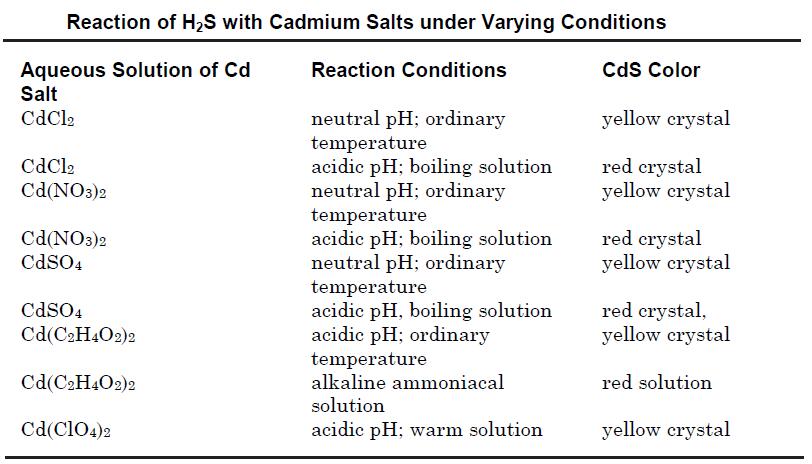Cadmiumsulfid Chemische Eigenschaften,Einsatz,Produktion Methoden
ERSCHEINUNGSBILD
HELLGELBE ODER ORANGE KRISTALLE ODER GELBES BIS BRAUNES PULVER
CHEMISCHE GEFAHREN
Die Substanz zersetzt sich beim Verbrennen unter Bildung von giftigen Rauchen mit Schwefeloxiden. Reagiert mit starken Oxidationsmitteln. Reagiert mit Säuren unter Bildung giftiger Gase (Schwefelwasserstoff).
ARBEITSPLATZGRENZWERTE
TLV: as Cd (Alveolengängige Fraktion) (als TWA); 0.002 mg/m?Krebskategorie A2 (Verdacht auf krebserzeugende Wirkung beim Menschen); BEI vorhanden; (ACGIH 2007).
MAK: Cd & anorganische Verbindungen (Einatembare Fraktion) Hautresorption (H); Krebserzeugend Kategorie 1; Keimzellmutagen Kategorie 3A (DFG 2007).
AUFNAHMEWEGE
Aufnahme in den Körper durch Inhalation des Aerosols und durch Verschlucken.
INHALATIONSGEFAHREN
Eine gesundheitsschädliche Partikelkonzentration in der Luft kann schnell erreicht werden beim Dispergieren, vor allem als Pulver.
WIRKUNGEN BEI KURZZEITEXPOSITION
WIRKUNGEN BEI KURZZEITEXPOSITION: Kann mechanische Reizungen der Augen verursachen.
WIRKUNGEN NACH WIEDERHOLTER ODER LANGZEITEXPOSITION
Möglich sind Auswirkungen auf die Nieren, Knochen und die Atemwege mit nachfolgenden Nierenschäden, Osteoporose (Knochenschwäche) und chronischer Entzündung der Atemwege. Krebserzeugend für den Menschen.
LECKAGE
Persönliche Schutzausrüstung: Atemschutzgerät mit Partikelfilter entsprechend der Arbeitsplatzkonzentration des Stoffes. Verschüttetes Material in Behältern sammeln; falls erforderlich durch Anfeuchten Staubentwicklung verhindern. Reste sorgfältig sammeln. An sicheren Ort bringen. NICHT in die Umwelt gelangen lassen.
R-Sätze Betriebsanweisung:
R45:Kann Krebs erzeugen.
R22:Gesundheitsschädlich beim Verschlucken.
R48/23/25:Giftig: Gefahr ernster Gesundheitsschäden bei längerer Exposition durch Einatmen und durch Verschlucken.
R53:Kann in Gewässern längerfristig schädliche Wirkungen haben.
R62:Kann möglicherweise die Fortpflanzungsfähigkeit beeinträchtigen.
R63:Kann das Kind im Mutterleib möglicherweise schädigen.
R68:Irreversibler Schaden möglich.
S-Sätze Betriebsanweisung:
S53:Exposition vermeiden - vor Gebrauch besondere Anweisungen einholen.
S45:Bei Unfall oder Unwohlsein sofort Arzt zuziehen (wenn möglich, dieses Etikett vorzeigen).
S61:Freisetzung in die Umwelt vermeiden. Besondere Anweisungen einholen/Sicherheitsdatenblatt zu Rate ziehen.
Chemische Eigenschaften
Cadmium sulfide is an odorless, crystalline,
lemon yellow to orange solid.
Physikalische Eigenschaften
Yellow to orange crystal; occurs as two polymorphs, hexagonal alpha form and cubic beta form; exhibits stable wurtzite structure at lower temperature, and zinc blende type structure at higher temperatures; the beta form converts to alpha form when heated at 750°C in sulfur atmosphere; sublimes at 980°C; practically insoluble in water (1.3 mg/L at 20°C); Ksp 3.6x10-29; dissolves in dilute mineral acids on heating or concentrated acids at ordinary temperatures (decomposes with liberation of H
2S).
Occurrence
Cadmium sulfide occurs in nature as the mineral greenoktite. The compound is widely used in pigments for paints, baking enamels, ceramics and plastics. It imparts bright yellow to maroon, with strong retention of color and resistance to alkalis. It also is used in inks, phosphors, and fluorescent screens. Other applications of this compound are in photovoltaic and solar cells (for converting solar energy to electrical energy), photoconductors (in xerography), thin film transistors and diodes, rectifiers, scintillation counters, pyrotechnics, and smoke detectors.
Verwenden
cadmium sulfide is used as a colorant for paints and rubber; cadmium acetate is used in the production of craftware.
Vorbereitung Methode
Cadmium sulfide may be prepared by the reaction between
hydrogen sulfide and cadmiumvapor at 800 Cor by heating a
mixture of cadmium or cadmium oxide with sulfur.
synthetische
Cadmium sulfide may be prepared by precipitation from an aqueous solution of its soluble salts such as cadmium chloride or cadmium nitrate by passing hydrogen sulfide. The reactions may be carried out in acidic, neutral or alkaline solutions using various cadmium salts to obtain different crystal modifications as shown in the table below.

Cadmium sulfide also may be obtained by treatment of sodium or other alkali metal sulfide solution with that of a soluble cadmium salt. The compound also may be prepared by heating a mixture of cadmium or its oxide with sulfur at 800°C; or by the reaction of H
2S with cadmium vapor at 800°C.
Definition
A native cadmium sulfide containing 77.7% cadmium. Ore of cadmium
Allgemeine Beschreibung
Natural occurrence: hawleyite (structural type of sphalerite) and greenockite (structural type of wurtzite)
Hazard
A confirmed carcinogen, highly toxic. See
cadmium.
Sicherheitsprofil
Confirmed human
carcinogen with experimental carcinogenic
and tumorigenic data. Moderately toxic by
ingestion and inhalation. Human mutation
data reported. When heated to
decomposition it emits very toxic fumes of
Cd and SOx. See also CADMIUM
COMPOUNDS and SULFIDES
mögliche Exposition
Used in pigments; as an active ingredient in dandruff shampoos; making photoconductors, solar
cells, and other electronic components.
Versand/Shipping
UN2570 Cadmium compounds, Hazard Class:
6.1; Labels: 6.1-Poisonous materials, Technical Name
Required.
Structure and conformation
Cadmium sulfide takes two types of structure, zinc blend and wurtzite structures.
Cubic system that has a zinc-blend structure, with a lattice constant of a=0.582 nm and Cd– S=0.252 nm.
Hexagonal system that has a wurtzite structure with lattice constants of a=0.4136 nm, c=0.6713 nm and c/a=1.624, Cd–S=0.252 nm.
Inkompatibilitäten
Contact with water or moisture releases
poisonous hydrogen sulfide gas. Incompatible with oxidizers (chlorates, nitrates, peroxides, permanganates, perchlorates, chlorine, bromine, fluorine, etc.); contact may cause
Waste disposal
Use a licensed professional
waste disposal service to dispose of this material. All federal, state, and local environmental regulations must be
observed. Consult with environmental regulatory agencies
for guidance on acceptable disposal practices. Generators
of waste containing this contaminant (≥100 kg/mo) must
conform to EPA regulations governing storage, transportation, treatment, and waste disposa
Cadmiumsulfid Upstream-Materialien And Downstream Produkte
Upstream-Materialien
Downstream Produkte

